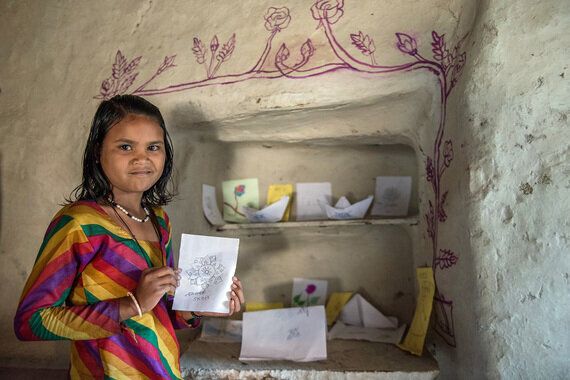Thursday is International Literacy Day, a chance to celebrate the power of reading in children's lives. If you're a book-lover yourself, you may remember curling up with your latest childhood treasure (it was Anne of Green Gables for me!)
With your kids back in the classroom, processing new information every day, you may wish you'd kept them reading more this summer. You're not alone. In a world of video games, YouTube, and social media, many Canadian families find that books stay shut on the shelves.
If your September resolution is to help your kids read more books, I have a suggestion. Why not consider building a reading corner in your home? I'll tell you how in a moment, but first, here's some evidence that it's worth the effort.
Reading corners work. Everywhere.
Reading corners are helping families improve reading all over the world -- even in countries where poverty rates are high. Programs like Literacy Boost , created by Save the Children and run in partnership with World Vision, help children read more at home, something that's critical for success in school.
In Ethiopia, ten-year-old Seble loves spending time in the reading corner she and her grandfather have made together. It has a small desk and bench for Seble to sit on, while doing her silent reading. The nook has no book shelf, but Seble has strung a 'book line' between her walls.

Seble's reading has improved since they built the reading corner, says her grandfather. Photo/Max Greenstein, Matter Studio
Half a world away, in India, eight-year-old Sakhi has a reading corner of her own. Here, she stores the activities she's completed, and the treasured books that she's borrowed from her Literacy Boost reading club.
"I like reading the most," says Sakhi. "But I also like the activity where we draw or write something we learned at the reading club. We take it home and store it in our reading corners."

Sakhi in her reading corner, which she's decorated to reflect her personality. Photo/World Vision
A global learning crisis
Reading corners -- and other measures like them -- have come just in time, say those who work with children in developing countries.
"There is a global learning crisis," says Linda Hiebert, World Vision's partnership leader for education and life skills. "Even with greater access to schools, 250 million children are completing Grade Four without basic literacy skills."
The reasons for the gap are understandable, but heartbreaking. Frequent illness, natural disasters, or the need to earn money to help support the family can all interfere with children's dreams of learning to read. School attendance suffers, meaning students get less reading time. They fall behind, lowering self-esteem.
Then there's the lack of engaging reading materials, written in children's native tongues. A school system may require that students learn to read in a language they have yet to learn -- English or French, for example. This can be overwhelming, especially when a hungry child is struggling to concentrate.
Literacy Boost's reading clubs -- along with its sessions for parents and caregivers supporting young readers -- are making a measurable difference. A key part of the success? Making child-friendly books available for loan, so children can read at home.
Why reading corners work
Whether overseas or here in Canada, having a simple reading corner in your home can work in three different ways:
- Help young brains switch on for reading: Knowing that there's a comfortable, quiet, fun place just for reading can often make all the difference.
- Add power to the primary years: Reading corners help boost children's reading during those early, foundational years, so they can understand and remember the tougher material later in school.
- Increase the 'brain food' in your home: Believe it or not, studies have shown that the volume of mentally stimulating content in your home may predict the structure of a child's brain later in life. Books are most definitely brain food!
How to build a reading corner
"Reading corners can be as big or small as a family's budget dictates," says Craig Geddes, World Vision's literacy program manager. You can make a reading corner in your home in three simple steps:
- Pick a cozy spot where your child can display their favorite books and crafts. Make sure the space is well-lit and that there's a comfortable place to sit (a pillow will do or you could use a small table and chair).
- Together with your child, decorate the reading corner. Your imagination is the only limit. You can add a shelf to display books; hang yarn or string between two corners and use clothes pins to display arts and crafts; and make your own literacy games with materials you might already have in your home (like this special version of Snakes and Ladders).
- Sit down together in the reading corner and enjoy a good book!
This last is perhaps the most enduring legacy of a designated reading corner. Seeing it is a reminder to parents to switch off the computer, and put down that cell phone. Then take a few minutes to read with your children.
They could be the best moments of your day.
Give the gift of improved education to children overseas through World Vision's new You Decide web page.
With files from Bryna Jones
Follow HuffPost Canada Blogs on Facebook
ALSO ON HUFFPOST:
